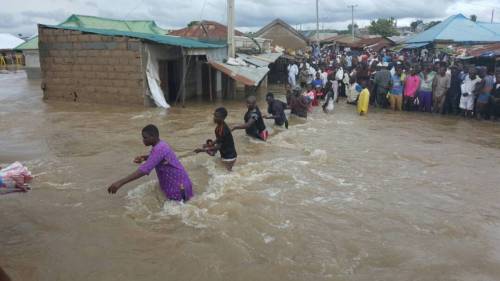
IN a season in which natural disasters have been wreaking havoc across the Americas and Asia, Nigeria has not been without her share of nature’s rage. The country may not be contending with hurricanes, heatwaves, earthquakes, volcanic eruption and typhoons that have killed hundreds in other parts of the world, but she has been confronted with a challenge that is likewise devastating. Many distraught citizens are struggling to cope with the impact of a recent flooding that has reportedly killed more than 100 people and displaced thousands of others.
With states such as Niger, Anambra, Kogi and Delta already declared disaster zones by the National Emergency Management Authority, others along the course of the country’s two biggest rivers, Niger and Benue, may have to brace for the worse. The disaster response agency says states such as Kebbi, Edo, Rivers, Taraba, Adamawa, Kwara and Bayelsa are among areas being monitored.
In many of the affected states, houses have been submerged, while some barely have their rooftops above the water line. Scores of villages have been washed away, according to reports, with Internally Displaced People camps springing up in dozens. Instead of cars, canoes have emerged as the means of movement within the affected areas. In a particular heart-rending incident, a blind man attempting to flee the flooding in Delta State reportedly lost his life when the boat that was carrying him capsized.
Yet, the situation could still be worse, since the rain has not yet abated. When a similar situation occurred six years ago, it was due to a lethal fusion of heavy rainfall and the release of water from a dam in neighbouring Cameroon, resulting in rivers overflowing their banks. In that incident, more than 430 people died in different states, spawning about 1.3 million displaced people. Just like the current experience, acres of farmland were submerged, resulting in the loss of yields worth billions of naira. It was Nigeria’s worst flooding in 40 years.
With the situation this bad, when water has not been released from Lagdo Dam, one can only imagine what would happen if it is eventually released. It would probably be worse than the 2012 experience. The Nigeria Hydrological Services Agency has already said that the level of water in Lokoja as of August 29, 2018 “has exceeded the corresponding volume on August 29, 2012.” This follows reports that both Kainji and Jebba dams were already spilling water downstream.
Indeed, reports quoting Cameroonian officials indicate that the Lagdo Dam water could be released, “depending on the level of water there to avoid risking its facilities.” This is a warning to states like Benue and Kogi, especially the latter, which is at the confluence of the rivers Niger and Benue. Both states have to evacuate their people to places of safety before disaster strikes. To residents in these areas, this is a disaster foretold, which should be effectively managed to reduce the level of human casualties.
Besides the places already reported, many cities still face the prospects of flooding due to the deleterious effects of human activities on the environment. NIHSA identifies some of these activities as blockage of drainage systems and poor urban planning. Other factors include rainstorms and coastal flooding as a result of sea rise. With the prediction of rain only ceasing in the southern part of the country in December, at the earliest, it is expected that cities like Lagos, Port Harcourt and Calabar, among others, in the South, should work on their urban planning culture. Efforts should be made to clear clogged drainage and pull down structures erected on known waterways, even when water may have temporarily receded from such areas.
These are indeed challenging times for both the government and the citizens. Man may not have developed the technology to tame the destructive capabilities of nature; but they have one that can predict natural disasters. It is left for people to act fast when reports of impending disasters are released. In Delta State, for instance, the Governor, Ifeanyi Okowa, complained that some people refused to be evacuated. Thankfully, the governor knows that it is his duty to prevent his citizens from “committing suicide” by staying put in the face of an oncoming disaster.
The world over, natural disasters have been wreaking havoc. In Japan, more than 150 people died following torrential rainfall that triggered landslides in western parts of the country, according to reports by The Japan Times. The country was also a victim of unprecedented heatwave that claimed more than 65 lives, forcing the authorities to declare it a natural disaster. Though the volcano that erupted in Hawaii caused minimal damage to humans, the recent Hurricane Florence in the United States reportedly claimed 42 lives, about 3.4 million poultry birds, and 5,500 pigs.
In all the situations, the difference was in how the emergency team responded. In Japan, the authorities, apart from setting up the usual IDP camps and promptly evacuating the people, have come up with hazard maps, showing flooding and landslides risk-prone areas. By publicising such maps, people know where not to build houses. But in the case of the Hawaii volcano, people were airlifted to safety at the height of the spewing stream of fire.
With the reality of climate change no longer in contention, Nigerians, and indeed the whole world, should brace themselves for many such disasters. After years of dealing with flooding, NEMA should demonstrate the capacity to handle such a situation. The agency should also learn from the experiences of others. It is heartening that President Muhammadu Buhari released an equivalent of $8.3 million to battle the flooding, but equipping disaster response agencies should not be an ad hoc measure. Above all, time is of essence in dealing with disasters. As the Hurricane Florence experience has shown, many of those that died lost their lives inside their cars, trying to escape. If they had acted faster, perhaps more lives would have been saved.
END

Be the first to comment